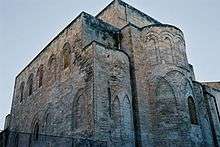La Magione, Palermo
The Basilica of the Most Holy Trinity (Italian: Basilica della Santissima Trinità), commonly known as Basilica del Cancelliere, Basilica La Magione or simply La Magione, is a Norman church of Palermo. It was completed in 1191 and is the last church built in the capital of the Norman Kingdom of Sicily during the period of the Hauteville dynasty. Its foundation is linked to the Chancellor of the Kingdom, Matthew of Ajello. Initially attributed to the Cistercians, during the period of the Hohenstaufen dynasty the church became the main house of the Teutonic Order. It is located in the quarter of the Kalsa, within the historic centre of Palermo.[1]

| Basilica of the Most Holy Trinity | |
|---|---|
Basilica della Santissima Trinità (in Italian) | |
 Façade of the Basilica | |
| Religion | |
| Affiliation | Roman Catholic |
| Province | Archdiocese of Palermo |
| Rite | Roman Rite |
| Location | |
| Location | Palermo, Italy |
| Geographic coordinates | 38°06′49″N 13°22′08″E |
| Architecture | |
| Style | Arab-Norman |
| Completed | 1191 |
| Website | |
| Official site | |
History
Some accounts trace the origin of the church to the 1150s. The church was built in the area of an old mosque. In 1191 the powerful Chancellor Matthew of Ajello entrusted the church to the Cistercians. In 1193 the prince Roger III of Sicily, son and heir of King Tancred of Sicily, was buried in this church. In 1194 Tancred himself was buried here.
After the death of Tancred the Kingdom was conquered by the Holy Roman Emperor Henry VI, husband of Constance of Hauteville, daughter of King Roger II of Sicily. In 1197 the church and its monastic fiefs was confiscated from the Cistercians and given to the Teutonic Knights. Their presence ensured the protection of young King Frederick II for over a decade during his minority. The knights built dormitories, an armoury and stables.
In 1492, at the request of Pope Innocent VIII, King Ferdinand II of Aragon, removed the Teutonic Order from Sicily. The complex became a residence for priests and abbots under the administration of the archbishop of Palermo. In 1780 it passed unto direct control of the Bourbon of Naples and in 1787 it was given to the Sacred Military Constantinian Order of Saint George. This situation ended with the unification of Italy in 1861.
In 19th century an important restoration was realized by Giuseppe Patricolo. Another restoration was realized after the Second world war. The church has the title of Minor basilica.
Gallery
 Apse
Apse_Kircheninneres-2011-08-03.jpg) Interior. Central nave
Interior. Central nave- Tabernacle
 Fresco of Madonna delle Grazie
Fresco of Madonna delle Grazie Cloister
Cloister Portal of the complex
Portal of the complex